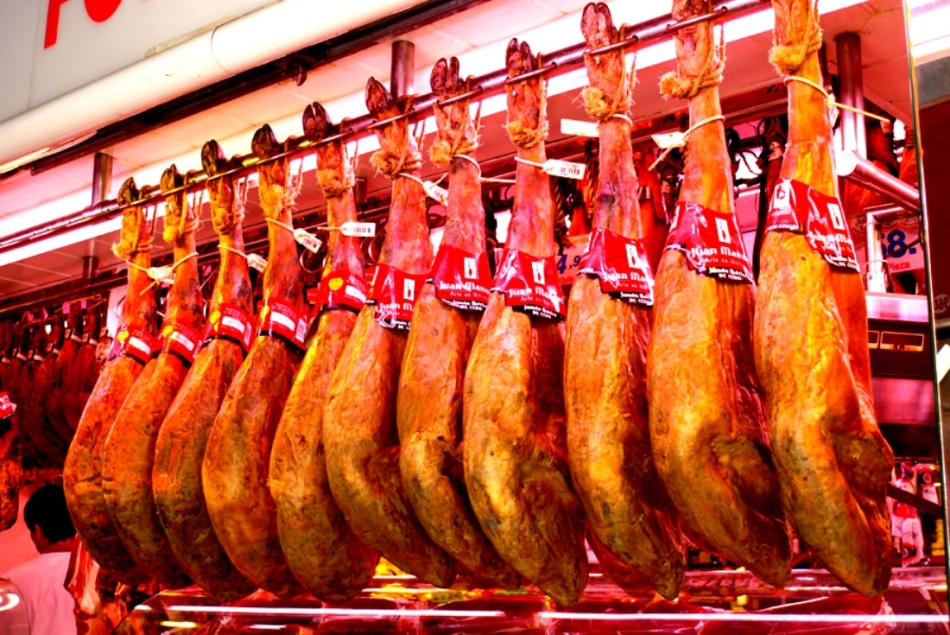From this article you will learn what Hamon is, and how to cook it.
Content
Hamon is a Spanish national dish. They make it from the posterior pork legs for a long time: first salt, then dried and sluggish. How to cook Hamon? We find out in this article.
What is Hamon?

Hamon is the back pork leg, prepared first by pickling, and then with a jerking for a long time. Hamon is a delicacy, and is very expensive.
Front pork legs Also prepared according to the same recipe as a hamon, but the name of the finished dish is different - palet. There are less meat on the front legs, and the palette is therefore cheaper than a hamon.
Hamon began to cook close 2 thousand years ago to save meat longer, because there were no refrigerators then.
Hamon is 2 types:
- Iberico
- Serrano
Iberico - Hamon, prepared from a pig of the Iberico breed, which was brought out specifically for the preparation of Hamon. The pigs of this breed are black, and their meat is very tender and soft.
Serrano - Hamon, prepared from an ordinary and unfortunate pig. Such a hamon is cheaper.
How Hamon is prepared: Instructions

To fully prepare a hamon, you need to spend 2-3 years. All the preparation of Hamon is divided into 6 stages:
- Salting. After the pigs were cut, the excess lard is cut out of the rear horrks, and the ham is laid in a large vessel and poured with sea salt so that the salt is completely covered with meat and put in a cold place (about +5̊c). The duration of the sucking depends on the size of the ham, usually how many kilograms the pork leg weighs, for so many days it needs to be salted, but not more than 2 weeks.
- Salt washing. Salt is washed off with pork legs with clean water and suspended so that the glass and the ham are dried.
- Succinement. In special chambers with the same cool temperature, the ham is suspended for a long time, for about 2 months, there they are evenly sucked.
- Drying. Then the ham in a suspended state is dried in a ventilated room, and the meat is impregnated with fat. This stage takes 6-36 months.
- Drying. The ham is transferred to the cellar with a special microclimate and temperature +8-10̊ C, suspended, and here they ripen completely, it will take 9-12 months.
- Hamon is ready, you can try. When Hamon is ready, the Cortador first tries him (a person specially trained to cut and serve a hamon). He pierces Hamon in several places with a special bone wand, and sniffs it, determining the readiness of the smell.
The average weight of Hamon is about 8 kg. In the homeland of Hamon, in Spain, it is sold everywhere: meat shops, restaurants and supermarkets.
How do Hamon eat?

Hamon is cut into thin, almost transparent slices. At home, in Spain, it is served with figs or melon - and no sandwiches. The combination of salt meat with sweet fruits gives an incredible taste.
If a combination with fruits does not suit you, then a hamon can be served with stewed vegetables, especially eggplant, zucchini, tomatoes, green beans, cabbage, and herbs.
From drinks, it is advisable to serve dry or half -dry red wine, beer to Hamon.
What mistakes are made when preparing a hamon at home: warnings

If you want to cook a hamon at home, take into account errors that are often repeated, and do not make them:
- You can not cut the entire skin with a pork leg, but only a small part, the skin protects the meat from drying out.
- If the ham is covered with a thick layer of fat, it needs to be cut off, otherwise the salt does not reach the meat, and the meat will not suck.
- You need to use large sea salt, it stretches excess moisture from meat.
- If white spots on the ham performed when drying - everything is fine, the meat did not go bad, it is so that salt works.
- Make sure that the skin remains intact throughout the entire process of preparing a hamon, if it is punctured at least in one place, all the ham may deteriorate.
- If dark spots appear on the ham when dried, you do not need to cut them off, but wipe them with alcohol.
- Hamon should start cooking in winter.
- If Hamon cutting is delayed for several days so that the edge of the Hamon does not weathered, it is lubricated with stomped butter or vegetable oil.
So, now we know a little more about such a delicacy as Hamon.







